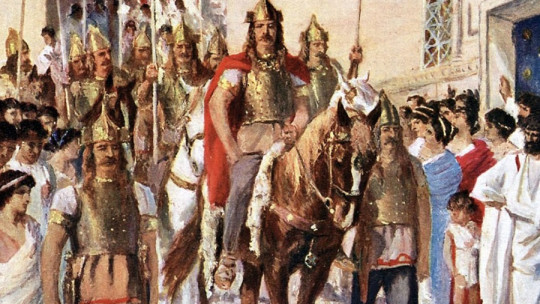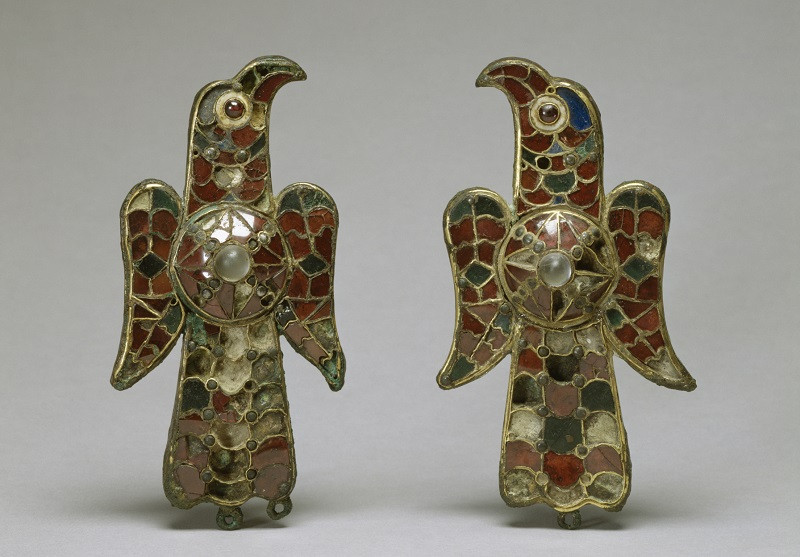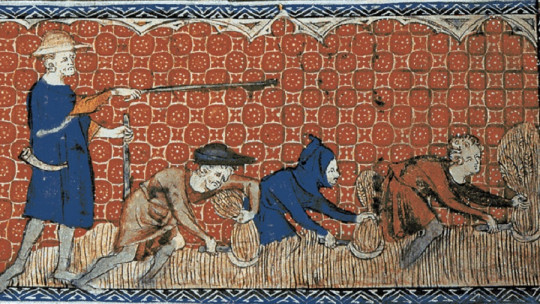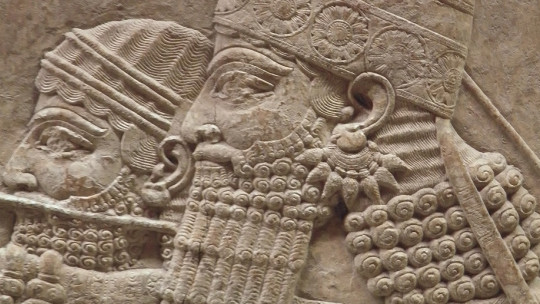
The Visigoths were part of the so-called “barbarian invasions”: penetrations of peoples, mostly of German origin, within the borders of the Roman Empire. These invasions further undermined Rome’s already weak situation, and precipitated the fall of the Roman Empire in the 5th century AD.
In this article we offer you a brief tour of the history of the Visigoths
Where did the Visigoths come from?
As with many ancient peoples, the origin of the Visigoths remains hidden in the shadows. It is known that it was a people that was part of the great family of Indo-European peoples, but the exact location of its origin is unknown.
Let’s see below some theories in this regard.
The Eastern Goths and the Western Goths
It is important to clarify that the Visigoths were a branch of a much larger group of peoples, the Goths.
In fact, The word Visigoths simply means Western Goths: that is, those who settled in the western part of the Roman Empire.
Both these Visigoths and the Ostrogoths (Eastern Goths) belonged to a great people who moved, from the 4th century AD, towards the Roman borders. But where did they travel from?
The Baltic, the original homeland of the Goths?
The Baltic origin of this people is more or less accepted by experts, although there are many historians and anthropologists who still have doubts about it. In fact, the tradition that points to the Baltic origin of the Goths (specifically, Scandinavia) is based on confusing and poorly contrasted sources.
The main source of information is Jordanes, a writer from the time of Justinian (6th century), also of barbarian origin, by the way. In his work De origine actibusque Getarum (“On the Origin and Actions of the Getae”), Jordanes places the homeland of the Getae in the Baltic; specifically, in a place he calls Scandza (or Escandia), and which has come to be identified as Scandinavia.
Another source that has been used to specify the origin of the Goths is Saint Isidore of Seville who, in his book History of regibus Gothorum, Vandalorum et Suevorum (“History of the Kings of the Goths, the Vandals and the Suebi”) recovers Jordanes’ idea and once again places the Gothic origin in Scandinavia. However, according to some historians, the identification of the Getae with the Goths is erroneous. They would then be different peoples, so the theory, based on Jordanes, that the Goths came from Scandinavia would also be erroneous.
So where do the Goths come from?
The new theories
Recently, new theories have appeared in this regard, which point to the mouth of the Vistula River, in present-day Poland, as the original place of the Goths. This hypothesis seems to be supported by archaeological evidence. Indeed, remains of a civilization have been found in the area, which has been called the Wielbark culture, which would have developed between the 1st century BC and the 4th century AD, dates that would correspond to the rise of the Gothic peoples in Europe. .

The remains of this culture show mixed funerary rites, which include burial and cremation, and circular stone constructions. Furthermore, the Wielbark culture presents a curious poverty of precious materials and iron, a fact that coincides with what the Roman historian Tacitus (1st century AD) stated about the Goths. If this provenance is true, then The Visigoths would be more related to the Latvian and Lithuanian cultures than to the German culture
Visigoths and Romans
Of the tribes that penetrated the Empire, the Visigoths are counted as one of the most Romanized peoples. However, in the early days they were nothing more than one of the many enemies that the Romans had beyond the borders. And much later, when the Visigoths were already settled in Roman territory and had an alliance with the Empire, their relations were not always friendly, as we will see later.
In the 3rd century AD, Rome is immersed in a crisis that historians have called “military anarchy.” Indeed, since the death of Emperor Alexander Severus (235 AD), ephemeral powers have taken place in different regions and the economic crisis has intensified.
This political and social instability obviously affects the borders, which are radically affected and greatly weakened. This facilitates the mobilization of the towns that are beyond the Roman limes; peoples who, in a generic way, have been called barbarians (a derogatory word of Greek origin that designated foreigners). This is the case of the Visigoths, of whom we know of attempts to penetrate the Empire since the end of the 4th century.
Gala Placidia and Ataúlfo: a union between cultures
At the beginning of the following century, the Visigoths, commanded by their king Alaric I, entered the Italian Peninsula. In 410 they sacked Rome, which filled the Romans with terror: the barbarians found themselves at the doors of their house. During the sacking, Gala Placidia, the sister of the emperor Honorius, is taken prisoner which the Visigoths intend to use as a bargaining chip in future negotiations.
Under the command of Ataulf, Alaric’s successor, the Visigoths left Italy and, under a peace treaty with Rome, settled in southern Gaul (412). But the recent union of Ataúlfo with Gala Placidia (in which legend sees an intense love story) is not to the liking of the Romans; Nor is the particular rebellion that the Visigoth king shows towards them. Thus, after a brief period of peace and apparent concord, the Visigoths once again clashed with the Romans, and were defeated by the troops of the Magister Militum Constantius.
King Ataúlfo is assassinated in Barcino, a city where the Visigoths had settled and which, according to many historians, can be considered the first Gothic capital in Hispania. Walia, his successor, tries to establish a new pact with Rome, and obtains from the Romans the promise of food and supplies in exchange for fighting the Vandals, Suebi and Alans, who were also causing problems for the Empire. In the pact too The delivery of Gala Placidia, the widow of King Ataúlfo, is contemplated, who finally returns to Rome and ends up marrying Constantius
These are the last breaths of a crumbling Empire. The Western Roman Empire has barely half a century left to live.
The Visigoths as federates of the Empire
In 418, under the reign of Theodoric I, the Visigoths finally settled in Aquitaine, southern Gaul, and in other cities outside the province, like Toulouse (Tolosa) which, in the end, will be the capital of his future kingdom They are foederati (federated) of the Empire: they receive grain and land from Rome in exchange for sporadic military services. Officially, the owner of the lands given as foedus remains the Empire; The Visigoths only settled there by virtue of the Roman hospitalitas. The pact was beneficial for the Romans, since, in exchange for an almost paltry amount of wheat, they had at their side the powerful Visigothic forces, which could be very useful to them in fighting the other invading peoples.
Thus, Visigoths and Romans joined forces to combat the Huns who, under the command of their fearsome leader Attila, had penetrated the Empire with blood and fire, coming from Asia. The combination of forces was a success, and The Huns were defeated at the Battle of the Catalaunic Fields, in French Champagne, in 451. The victory had a high price for the Visigoths, since their king, Theodoric, died in the battle. After the death of the Visigoth leader, a parenthesis of political instability began that the Romans took advantage of to his advantage.
The first kingdom: the Visigoth kingdom of Toulouse
The connection between the Visigoths and the Romans weakened over time. Theodoric II took advantage of the acute instability that the Empire was experiencing to expand Visigothic rule towards the south of Gaul, and also in Hispania. With the arrival of Eurico to the throne, the estrangement ended up becoming a new confrontation.
Under this new king, Visigothic conquests in Hispania multiply ; The region became an extension of the Visigoth kingdom of Toulouse, with the exception of the areas inhabited by Cantabrians and Basques, part of Baetica and, of course, Gallaecia, which was still in the power of the Suebi.
It was clear, then, that the Visigoths were an unstoppable force that threatened to annex the entire western part of the Empire to their kingdom.
Enemies of the Romans, but not of their culture
Despite the growing enmity between King Eurich and Rome, this did not mean that the Visigoths wanted to destroy the cultural traces that the Roman Empire had left in Europe. Quite the contrary; We have already said that the Visigoths were one of the most Romanized peoples.
Probably aware of the organizational superiority of the Roman administration, as well as of his law, Euric surrounded himself with Roman jurists and developed the famous Codex Euricianus o Eurico Code a compendium of laws by which both Romans and Visigoths had to be governed.
With the final dismemberment of the Roman Empire, which occurred in 476, Euric gained enough freedom to finish conquering part of the territory of the coveted Gaul, and thus put the finishing touch to the first Visigoth kingdom of Toulouse, now free of any Roman authority.
The Visigoth kingdom of Toledo
In northern Gaul another Germanic power had emerged that was a powerful rival for the Visigoths: the Frankish kingdom of Clovis The Franks were another of the invading peoples, of Germanic culture and coming from east of the Rhine.
Its expansion towards the south ended up colliding with the interests of the Visigoth kingdom of Toulouse; Both towns faced each other in the famous battle of Vouillé (507), in which the Visigoths were resoundingly defeated. Humiliated and cornered, they had no choice but to abandon Gaul and return to their Spanish lands. There they would consolidate a kingdom, with its capital in Toledo, which would survive no less than two centuries and would emerge as one of the most splendid kingdoms in Europe.
The golden age
At the moment, however, only the central part of Hispania was in the hands of the Visigoths. The Cantabrian and Basque north did not fall within their possessions, nor did Gallaecia, which continued to belong to the Suebi. The south, held by the Byzantines since Justinian’s Mediterranean expansion, was also outside their borders.
This is where it comes into play. one of the most important Visigoth kings: Leovigild Conquering king par excellence and determined to unify all of Hispania, Leovigild attacked the Byzantines and launched conquest campaigns against Swabian Gallaecia. In these campaigns he had successes and defeats; Despite recovering a good part of Byzantine Spania, he did not manage to annex it completely (the Byzantines did not leave the Peninsula until the beginning of the 7th century, with King Suintila).
The Swabian kingdom did fall under the push of Leovigild, and became part of the Visigoth kingdom. He also managed to annex the Cantabrian area, an area that, since Roman times, had been rebellious to any external authority. Leovigild also penetrated Basque territory and achieved some military victories there.
Leovigild is the architect of the Code of Leovigild, a revision of the laws promulgated by Eurich Among many of the innovations of the new code, the legalization of mixed marriages stands out. Until then, Hispano-Romans and Visigoths could not marry; Leovigild’s Code lifted the prohibition, which facilitated the construction of a new Roman-Visigothic society.
Conversion to Catholicism
The Visigoths had been, at first, pagans. Later, they converted to Arianism, one of the most widespread Christian heresies of the time. Finally, and very aware of the political and social benefits it entailed, King Recaredo converted to Catholicism in the year 587, a conversion that would be ratified, along with that of the entire Visigoth nobility, at the Third Council of Toledo (589). From then on, all Visigoths abandoned Arianism and became defenders of the Roman faith.
The Muslim invasions and the end of the Visigoth kingdom of Toledo
The 8th century would mark the end of Visigothic power in Hispania. King Witiza was murdered, and the Visigoth nobility was divided into two: those loyal to the dead king’s side and those who supported the usurper, the new king Rodrigo. The context of political crisis only facilitated the already rapid advance of the Muslims: in 711 they penetrated the Peninsula, possibly, and according to some authors, encouraged by the faction opposed to Rodrigo, who trusted the newly arrived to put an end to the usurper king.
However, the plan did not go as expected. Because The entry of the Muslims did not mean a change of king, but rather the absolute annihilation of the Visigoth kingdom of Toledo The Visigothic administration disintegrated, and the Muslims advanced without problems beyond the Pyrenees. Only in the Asturian part was a stronghold free from the invading power; stronghold where, over the years, the first Asturian kingdom would be formed.








